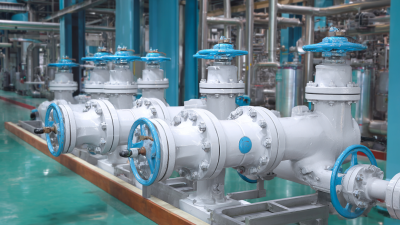
In the realm of modern fluid management systems, the significance of sight flow indicators cannot be overstated. According to a report by the American Society of Mechanical Engineers (ASME), improper management of fluid flow accounts for approximately 30% of operational inefficiencies in various industrial applications. Sight flow indicators serve as crucial tools that provide real-time visual feedback on fluid movement, enhancing operational transparency and safety.
 By allowing operators to monitor flow characteristics, such as clarity and consistency, these indicators play a pivotal role in preventing costly downtimes and ensuring compliance with industry regulations. Additionally, a survey conducted by the Fluid Controls Institute highlights that systems equipped with sight flow indicators experience up to a 25% reduction in maintenance costs due to early detection of potential issues. Thus, understanding the importance of sight flow indicators is essential for optimizing fluid management strategies in today’s competitive landscape.
By allowing operators to monitor flow characteristics, such as clarity and consistency, these indicators play a pivotal role in preventing costly downtimes and ensuring compliance with industry regulations. Additionally, a survey conducted by the Fluid Controls Institute highlights that systems equipped with sight flow indicators experience up to a 25% reduction in maintenance costs due to early detection of potential issues. Thus, understanding the importance of sight flow indicators is essential for optimizing fluid management strategies in today’s competitive landscape.
Sight flow indicators play a crucial role in enhancing fluid monitoring accuracy within modern fluid management systems. By providing a real-time visual representation of fluid movement, these indicators enable operators to quickly assess the status of the processes being monitored. The clear visibility offered by sight flow indicators helps in detecting changes in flow rates, identifying potential blockages, and ensuring optimal operation of the system. This immediate feedback is essential for maintaining the integrity of fluid processes, reducing downtime, and preventing costly errors.
Furthermore, sight flow indicators also contribute to enhanced safety measures within industrial settings. Their ability to clearly display the flow direction and characteristics of the fluid allows personnel to make informed decisions when responding to system changes or anomalies. This transparency not only aids in operational efficiency but also promotes a safer working environment by reducing the risk of mishandling or misinterpretations regarding fluid behavior. In summary, sight flow indicators are indispensable tools that significantly improve fluid monitoring accuracy while simultaneously supporting safety protocols in fluid management systems.
Sight flow indicators play a crucial role in modern fluid management systems, providing visual confirmation of the flow direction and condition of liquids within a pipeline. Understanding their key specifications and standards is essential for ensuring system efficiency and safety. Typically, sight flow indicators are designed to withstand specific pressure and temperature ranges, which are dictated by industry standards such as ASME and ANSI. These standards help manufacturers ensure that their indicators can perform reliably under a variety of operational conditions.
In addition to pressure and temperature ratings, the materials used in the construction of sight flow indicators can significantly affect their performance and longevity. For instance, indicators made from glass, plastic, or metals must adhere to compatibility guidelines with the fluids they will come into contact with. This ensures that the sight flow indicators do not corrode or degrade over time, which could lead to system failures. Compliance with relevant safety standards further guarantees that these devices are suitable for the working environment, minimizing risks associated with leaks or ruptures.
Understanding these specifications and standards is vital for professionals involved in fluid management to select and maintain the right equipment for their systems.
The significance of sight flow indicators (SFIs) in fluid management systems cannot be overstated, particularly when comparing traditional and modern designs. Traditional SFIs, often constructed from glass, have been widely used for decades. They provide a simple visual indication of flow direction and fluid characteristics. However, a report by the Fluid Handling Association indicates that these traditional indicators have limitations in terms of durability and safety. Glass can break under high pressure or extreme temperatures, leading to potential hazards in industrial settings.
In contrast, modern sight flow indicators incorporate advanced materials such as tempered glass, acrylic, or even polycarbonate, which significantly enhance their resilience. According to a recent industry analysis by the American Society of Mechanical Engineers, these modern indicators can withstand increased operating pressures and temperatures of up to 300% more than their traditional counterparts. Furthermore, innovations like LED illumination and various sensing technologies have transformed how operators monitor fluid dynamics, allowing for real-time data analysis and improved operational efficiency. This evolution reflects the ongoing demand for safer, more reliable, and efficient fluid management systems in various industrial applications.

Sight flow indicators play a crucial role in enhancing operational safety and efficiency within modern fluid management systems. These devices allow operators to visually monitor the flow of liquids and gases in real time, thereby providing essential information for maintaining optimal system performance. By clearly displaying the flow rate and condition of the media, sight flow indicators help detect issues such as blockages, leaks, or fluctuations in pressure. This immediate feedback allows for timely interventions, reducing the risk of accidents and ensuring that processes run smoothly.
Furthermore, the presence of sight flow indicators contributes to overall operational efficiency by facilitating quick decision-making. Operators are better equipped to identify inefficiencies or malfunctions, enabling prompt repairs or adjustments. This not only minimizes downtime but also enhances resource management by preventing waste and ensuring that systems operate within their designed parameters. In industries where fluid management is vital, the integration of sight flow indicators is an essential practice for fostering a safe and efficient working environment, ultimately leading to improved productivity and cost-effectiveness.

The future of sight flow indicator technology in fluid management systems is poised for significant advancements, driven by the increasing demand for efficiency and precision in various industries. According to a report by MarketsandMarkets, the global flow indicator market is projected to grow from $2.45 billion in 2023 to $3.26 billion by 2028, reflecting a CAGR of 6.1%. This growth is largely attributed to the integration of smart technologies and IoT capabilities that enhance the monitoring and control of fluid dynamics within systems.
Emerging trends indicate that manufacturers are focusing on developing sight flow indicators that not only provide visual confirmation of flow but also incorporate real-time data analytics. For instance, the use of augmented reality (AR) in conjunction with sight flow indicators empowers technicians to visualize flow rates and diagnose issues practically on-site. Moreover, advancements such as corrosion-resistant materials and environmentally friendly designs are also becoming pivotal, as industries strive for sustainability. A study by TechSci Research found that nearly 40% of fluid management professionals prioritize durable and eco-conscious materials when selecting sight flow indicators, signaling a shift towards more sustainable practices in fluid management.





